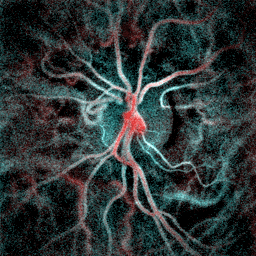Collateral Circulation on:
[Wikipedia]
[Google]
[Amazon]
Collateral circulation is the alternate Dictionary.com collateral circulation
/ref> It may occur via preexisting vascular redundancy (analogous to engineered redundancy), as in the circle of Willis in the brain, or it may occur via new branches formed between adjacent blood vessels ( neovascularization), as in the eye after a
 After central retinal vein occlusion, neovascularization may restore some blood flow to the retina, but the new vessels' bulk also presents a risk of causing acute
After central retinal vein occlusion, neovascularization may restore some blood flow to the retina, but the new vessels' bulk also presents a risk of causing acute
circulation
Circulation may refer to:
Science and technology
* Atmospheric circulation, the large-scale movement of air
* Circulation (physics), the path integral of the fluid velocity around a closed curve in a fluid flow field
* Circulatory system, a bio ...
around a blocked artery or vein via another path, such as nearby minor vessels./ref> It may occur via preexisting vascular redundancy (analogous to engineered redundancy), as in the circle of Willis in the brain, or it may occur via new branches formed between adjacent blood vessels ( neovascularization), as in the eye after a
retina
The retina (from la, rete "net") is the innermost, light-sensitive layer of tissue of the eye of most vertebrates and some molluscs. The optics of the eye create a focused two-dimensional image of the visual world on the retina, which then ...
l embolism or in the brain when moyamoya occurs. Its formation may be provoked by pathological conditions such as high vascular resistance or ischaemia.
An example of the usefulness of collateral circulation is a systemic thromboembolism in cats. This is when a thrombotic embolus lodges above the external iliac artery (common iliac artery), blocking the external and internal iliac arteries
The internal iliac artery (formerly known as the hypogastric artery) is the main artery of the pelvis.
Structure
The internal iliac artery supplies the walls and viscera of the pelvis, the buttock, the reproductive organs, and the medial comp ...
and effectively shutting off all blood supply to the hind leg. Even though the main vessels to the leg are blocked, enough blood can get to the tissues in the leg via the collateral circulation to keep them alive.
Brain
Blood flow to the brain in humans and some other animals is maintained via a network of collateral arteries that anastomose (join) in the circle of Willis, which lies at the base of the brain. In the circle of Willis so-called communicating arteries exist between the front (anterior) and back (posterior) parts of the circle of Willis, as well as between the left and right side of the circle of Willis.Heart
Another example in humans and some other animals is after an acutemyocardial infarction
A myocardial infarction (MI), commonly known as a heart attack, occurs when blood flow decreases or stops to the coronary artery of the heart, causing damage to the heart muscle. The most common symptom is chest pain or discomfort which ...
(heart attack). Collateral circulation in the heart tissue will sometimes bypass the blockage in the main artery and supply enough oxygenated blood to enable the cardiac tissue to survive and recover.
Eye
 After central retinal vein occlusion, neovascularization may restore some blood flow to the retina, but the new vessels' bulk also presents a risk of causing acute
After central retinal vein occlusion, neovascularization may restore some blood flow to the retina, but the new vessels' bulk also presents a risk of causing acute glaucoma
Glaucoma is a group of eye diseases that result in damage to the optic nerve (or retina) and cause vision loss. The most common type is open-angle (wide angle, chronic simple) glaucoma, in which the drainage angle for fluid within the eye re ...
by blocking the drainage of aqueous humour. Collateral circulation is created (within months) around the blocked central vein via a generally winding path, usually from a branch vein to the choroid.
Truncal venous system
Hepatic cirrhosis
Cirrhosis, also known as liver cirrhosis or hepatic cirrhosis, and end-stage liver disease, is the impaired liver function caused by the formation of scar tissue known as fibrosis due to damage caused by liver disease. Damage causes tissue rep ...
arising from congestion in the hepatic portal vein may give rise to collateral circulation between branches of the portal and caval veins of the liver
The liver is a major organ only found in vertebrates which performs many essential biological functions such as detoxification of the organism, and the synthesis of proteins and biochemicals necessary for digestion and growth. In humans, it ...
, or between the two caval veins. Consequences of newly established venous collaterals arising from portal hypertension include esophageal varices and hemorrhoids (portocaval collateral circulation).
References
{{DEFAULTSORT:Collateral Circulation Angiology Fault tolerance